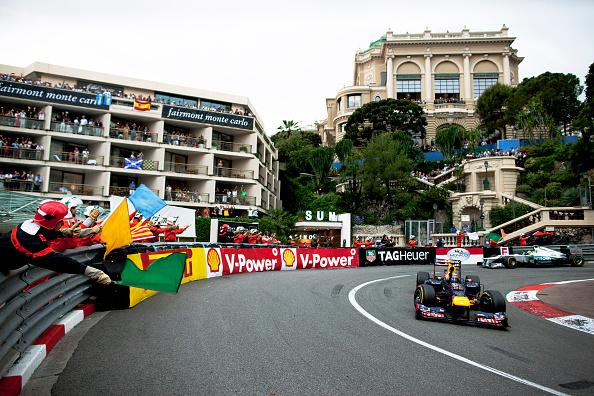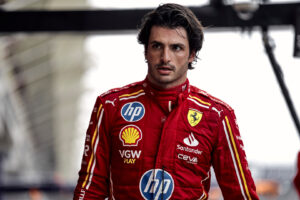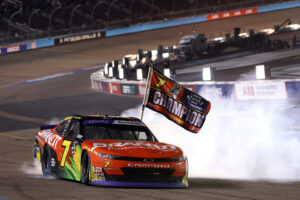In F1, ten different flags are used to indicate information to drivers. What exactly does each of them mean?
Hello and welcome to our new F1 Explained series. Today, we will look at F1 Flags and attempt to explain them in the simplest way possible. Throughout a Formula 1 race weekend, we often see marshals waving colored flags to the drivers, but what exactly do each of the flags mean? Let’s find out.
Yellow Flag
The yellow flag is seen in almost every race. It is used to alert drivers to a hazard on or near the track that could be a result of a collision, or mechanical or electrical failure. Drivers must slow down and are not permitted to overtake under yellow flag conditions. There are two kinds of yellow flags: single waved yellow flag and double waved yellow flag, each with its own meaning.
Single Waved Yellow Flag
When there is a danger on the side or part of the track, a single yellow flag is waved. For example, when a car deviates from the path or becomes stuck in the gravel. In that case, drivers must slow down and are not permitted to overtake until the incident has cleared.
Double Waved Yellow Flag
When an incident completely or partially blocks the track, a double yellow flag is waved. For example, when a car stops on the track or on the side of the track, affecting cars behind. In that case, drivers must slow down ‘significantly,’ avoid overtaking, and be prepared to stop or change their direction if the situation requires so.
The yellow flags also appear during a safety car period alongside a board that says “SC” – Safety Car – or “VSC” – Virtual Safety Car.
Green Flag
As we all know, green means go. The green flag indicates that any incident, debris, or obstructions that were causing a single or double yellow flag have been cleared off the racetrack and that drivers are allowed to resume racing under normal conditions.
The green flag is also waved behind the grid to signal the start of the practice or qualifying session, and at the start of each Grand Prix.
Red Flag
Red obviously means stop. The red flag is waved by marshals when conditions are unsafe to continue the race. When raised, the race is temporarily halted, and all cars should safely return to the pit lane until the cause of the red flag incident is resolved. Usually, the flag appears as a result of a hazardous situation such as a serious crash, bad weather condition, or poor track condition.
DID YOU KNOW? The 2021 season has set the record for the most red flags seen in a single year with FIVE. Red flags appeared during the Emilia Romagna GP, Azerbaijan GP, British GP, Hungarian GP, and Belgian GP. The latter was the shortest race in Formula 1 history, lasting for only 3 minutes and 27 seconds due to heavy rain, taking the claim from the 1991 Australian Grand Prix.
Red and Yellow Striped Flag
The red and yellow striped flag warns drivers when the track is slippery due to water or an oil spill. If the flag is moved horizontally (not waved), it indicates that there is an animal on the track. (Yeah, it happens!)
Godzilla 🦎
'A horse with horns' 🦌
And a pair of cheeky seagulls 😂Groundhogs are far from the only wildlife we're used to seeing in F1…#F1 #GroundhogDay pic.twitter.com/rM4yLntG5W
— Formula 1 (@F1) February 2, 2020
White Flag
A white flag indicates the presence of a slow-moving vehicle ahead. It is usually caused by a non-racing car such as a fire truck or ambulance on the track. It is also used at the end of free practice sessions when drivers stop in a grid slot to practice their starts ahead of the race.
Black Flag
A black flag is one that no Formula 1 driver wants to see. It’s the same as the red card in football. If a driver is shown a black flag, it means they have violated the sport’s regulations and are thus disqualified. They must immediately return to their pits. The Race is over!
The last time a black flag was waved was during the Canadian Grand Prix in 2007 when both Ferrari’s Filipe Massa and Renault’s Giancarlo Fisichella were shown black flags for passing a red light going out of the pitlane. The red light is used to control the exit of drivers from the pitlane. When it’s on, drivers are not allowed onto the racetrack until the light is switched off.
Blue Flag
The blue flag is one of the flags most commonly used in Formula 1. It indicates that the driver in front who is one or more laps down must let the faster car(s) behind them pass. If the driver ignores three consecutive flags, a penalty is issued to the driver.
It happened to ex-Haas driver Nikita Mazepin at the 2021 Portuguese Grand Prix when he received a five-second time penalty after ignoring five blue flags for blocking Red Bull’s Sergio Perez.
Another incident occurred at the 2021 Turkish Grand Prix when Mazepin blocked Lewis Hamilton and caused him to lose time but was only given one blue flag.
Mazepin fechando o Lewis Hamilton ksksksjsksksksk#F1naBand pic.twitter.com/s952zfnSnu
— Wendel🐔🏁 (@uee_wendel) October 10, 2021
Black and Orange Flag
This is yet another flag that no Formula 1 driver wants to see. The black flag with an orange circle is shown not for breaking the rules, but for having a problem with the car. Seeing the flag necessitates the driver to return to the pit lane to fix the issue or retire.
Black and White Flag
Formula 1’s black and white flag is equivalent to football’s yellow card. It is used to warn the driver of unsportsmanlike behavior and is waved alongside a sign with the driver’s number to identify the recipient of the warning. If the driver ignores the flag, he gets a penalty.
This flag was shown to Max Verstappen at the 2021 Brazilian Grand Prix for weaving on the straight. The moment he gave us the famous team radio message “yeah, perfect. Say hi!”
Chequered Flag
This is the most recognizable flag Formula 1 flag. Perhaps the fan favorite after the green flag. The chequered flag indicates that the race is finished or that the practice or qualifying session is completed.
DID YOU KNOW? Fans can now enter competitions to have their names added to a square of an F1 race-ending chequered flag. They can also buy squares to raise money for charity.
Sometimes, celebrities are given the honor of waving the chequered flag at the end of a race like David Beckham in Bahrain in 2019, and the retiring tennis legend Serena Williams at the Monaco Grand Prix in 2021.
As thrilling as it appears to be, waving the chequered flag can sometimes go horribly wrong. As was the case at the 2018 Canadian Grand Prix when Supermodel Winnie Harlow caused chaos after she accidentally ended the race by waving the flag a lap too early.
“IT WASNT ME” *Shaggy Voice* when they tell you to wave the flag a lap too early 😂😩😡🏁🏁 but I’m so grateful no one was hurt! 🙏🏽🏎 @F1 pic.twitter.com/2wBmH3SDOP
— ♔Winnie Harlow♔ (@winnieharlow) June 10, 2018
Intentionally, the writer is now waving a chequered flag, indicating the end of the F1 flag explanations.






